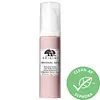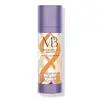What's inside
What's inside
 Key Ingredients
Key Ingredients

 Benefits
Benefits

 Concerns
Concerns

 Ingredients Side-by-side
Ingredients Side-by-side

Water
Skin ConditioningButylene Glycol
HumectantSilica
AbrasivePolymethylsilsesquioxane
Dimethicone
EmollientGlycerin
HumectantHdi/Trimethylol Hexyllactone Crosspolymer
Polysilicone-11
Citrus Grandis Peel Oil
MaskingLavandula Angustifolia Oil
MaskingPelargonium Graveolens Flower Oil
MaskingAmyris Balsamifera Bark Oil
MaskingSalvia Sclarea Oil
MaskingAnthemis Nobilis Flower Oil
MaskingRosa Centifolia Flower Extract
AstringentLimonene
PerfumingLinalool
PerfumingEpilobium Angustifolium Flower/Leaf/Stem Extract
Skin ConditioningAlbizia Julibrissin Bark Extract
MaskingCastanea Sativa Seed Extract
Skin ConditioningSalicylic Acid
MaskingPaeonia Suffruticosa Root Extract
Skin ProtectingSaccharum Officinarum Extract
MoisturisingLaminaria Saccharina Extract
Skin ProtectingBambusa Vulgaris Extract
Skin ConditioningPisum Sativum Extract
Skin ConditioningSigesbeckia Orientalis Extract
Skin ConditioningLaminaria Digitata Extract
Skin ProtectingAcetyl Hexapeptide-8
HumectantEthylhexylglycerin
Skin ConditioningCaffeine
Skin ConditioningUrea
BufferingLauryl PEG-9 Polydimethylsiloxyethyl Dimethicone
Skin ConditioningArginine
MaskingSodium Hyaluronate
HumectantPhospholipids
Skin ConditioningPEG-11 Methyl Ether Dimethicone
EmulsifyingDimethicone Crosspolymer
Emulsion StabilisingCaprylyl Glycol
EmollientSodium PCA
HumectantDimethicone/Vinyl Dimethicone Crosspolymer
Skin ConditioningMagnesium Ascorbyl Phosphate
AntioxidantGlucosamine Hcl
Sodium Phytate
Hexylene Glycol
EmulsifyingLaureth-12
EmulsifyingTrehalose
HumectantPolyquaternium-51
Skin ConditioningTromethamine
BufferingSilica Silylate
EmollientCarbomer
Emulsion StabilisingAmmonium Acryloyldimethyltaurate/Vp Copolymer
Tocopheryl Acetate
AntioxidantPotassium Sorbate
PreservativeChlorphenesin
AntimicrobialPhenoxyethanol
PreservativeMica
Cosmetic ColorantIron Oxides
CI 77891
Cosmetic ColorantWater, Butylene Glycol, Silica, Polymethylsilsesquioxane, Dimethicone, Glycerin, Hdi/Trimethylol Hexyllactone Crosspolymer, Polysilicone-11, Citrus Grandis Peel Oil, Lavandula Angustifolia Oil, Pelargonium Graveolens Flower Oil, Amyris Balsamifera Bark Oil, Salvia Sclarea Oil, Anthemis Nobilis Flower Oil, Rosa Centifolia Flower Extract, Limonene, Linalool, Epilobium Angustifolium Flower/Leaf/Stem Extract, Albizia Julibrissin Bark Extract, Castanea Sativa Seed Extract, Salicylic Acid, Paeonia Suffruticosa Root Extract, Saccharum Officinarum Extract, Laminaria Saccharina Extract, Bambusa Vulgaris Extract, Pisum Sativum Extract, Sigesbeckia Orientalis Extract, Laminaria Digitata Extract, Acetyl Hexapeptide-8, Ethylhexylglycerin, Caffeine, Urea, Lauryl PEG-9 Polydimethylsiloxyethyl Dimethicone, Arginine, Sodium Hyaluronate, Phospholipids, PEG-11 Methyl Ether Dimethicone, Dimethicone Crosspolymer, Caprylyl Glycol, Sodium PCA, Dimethicone/Vinyl Dimethicone Crosspolymer, Magnesium Ascorbyl Phosphate, Glucosamine Hcl, Sodium Phytate, Hexylene Glycol, Laureth-12, Trehalose, Polyquaternium-51, Tromethamine, Silica Silylate, Carbomer, Ammonium Acryloyldimethyltaurate/Vp Copolymer, Tocopheryl Acetate, Potassium Sorbate, Chlorphenesin, Phenoxyethanol, Mica, Iron Oxides, CI 77891
Water
Skin ConditioningCyclopentasiloxane
EmollientGlycerin
HumectantNeopentyl Glycol Diheptanoate
EmollientPentylene Glycol
Skin ConditioningCastor Isostearate Succinate
Skin ConditioningButylene Glycol
HumectantPolymethylsilsesquioxane
C30-45 Alkyl Cetearyl Dimethicone Crosspolymer
EmollientDimethicone Crosspolymer
Emulsion StabilisingCucumis Melo Fruit Extract
Skin ConditioningElaeis Guineensis Oil
EmollientHydrogenated Vegetable Oil
EmollientTocopheryl Acetate
AntioxidantSodium Hyaluronate
HumectantMagnesium Ascorbyl Phosphate
AntioxidantSoluble Collagen
HumectantMaltooligosyl Glucoside
Skin ConditioningCaprylyl Glycol
EmollientDecarboxy Carnosine Hcl
Skin ConditioningHexapeptide-9
Skin ConditioningTripeptide-3
Skin ConditioningSaccharomyces/Zinc Ferment
Skin ConditioningCholesterol
EmollientTocotrienols
Skin ConditioningTocopherol
AntioxidantDimethicone
EmollientEthylhexylglycerin
Skin ConditioningGlyceryl Acrylate/Acrylic Acid Copolymer
HumectantEthylhexyl Hydroxystearate
EmollientHydrogenated Phosphatidylcholine
EmulsifyingSilica Dimethyl Silylate
EmollientHydrogenated Starch Hydrolysate
HumectantHydroxypropyl Guar
Emulsion StabilisingPolysilicone-11
Aminomethyl Propanol
BufferingHexylene Glycol
EmulsifyingAlcohol
AntimicrobialDisodium EDTA
Carbomer
Emulsion StabilisingPhenoxyethanol
PreservativeParfum
MaskingAlpha-Isomethyl Ionone
PerfumingBenzyl Benzoate
AntimicrobialBenzyl Salicylate
PerfumingButylphenyl Methylpropional
PerfumingCitronellol
PerfumingGeraniol
PerfumingHexyl Cinnamal
PerfumingLimonene
PerfumingLinalool
PerfumingIron Oxides
CI 77891
Cosmetic ColorantWater, Cyclopentasiloxane, Glycerin, Neopentyl Glycol Diheptanoate, Pentylene Glycol, Castor Isostearate Succinate, Butylene Glycol, Polymethylsilsesquioxane, C30-45 Alkyl Cetearyl Dimethicone Crosspolymer, Dimethicone Crosspolymer, Cucumis Melo Fruit Extract, Elaeis Guineensis Oil, Hydrogenated Vegetable Oil, Tocopheryl Acetate, Sodium Hyaluronate, Magnesium Ascorbyl Phosphate, Soluble Collagen, Maltooligosyl Glucoside, Caprylyl Glycol, Decarboxy Carnosine Hcl, Hexapeptide-9, Tripeptide-3, Saccharomyces/Zinc Ferment, Cholesterol, Tocotrienols, Tocopherol, Dimethicone, Ethylhexylglycerin, Glyceryl Acrylate/Acrylic Acid Copolymer, Ethylhexyl Hydroxystearate, Hydrogenated Phosphatidylcholine, Silica Dimethyl Silylate, Hydrogenated Starch Hydrolysate, Hydroxypropyl Guar, Polysilicone-11, Aminomethyl Propanol, Hexylene Glycol, Alcohol, Disodium EDTA, Carbomer, Phenoxyethanol, Parfum, Alpha-Isomethyl Ionone, Benzyl Benzoate, Benzyl Salicylate, Butylphenyl Methylpropional, Citronellol, Geraniol, Hexyl Cinnamal, Limonene, Linalool, Iron Oxides, CI 77891
Ingredients Explained
These ingredients are found in both products.
Ingredients higher up in an ingredient list are typically present in a larger amount.
Butylene Glycol (or BG) is used within cosmetic products for a few different reasons:
Overall, Butylene Glycol is a safe and well-rounded ingredient that works well with other ingredients.
Though this ingredient works well with most skin types, some people with sensitive skin may experience a reaction such as allergic rashes, closed comedones, or itchiness.
Learn more about Butylene GlycolCaprylyl Glycol is a humectant and emollient, meaning it attracts and preserves moisture.
It is a common ingredient in many products, especially those designed to hydrate skin. The primary benefits are retaining moisture, skin softening, and promoting a healthy skin barrier.
Though Caprylyl Glycol is an alcohol derived from fatty acids, it is not the kind that can dry out skin.
This ingredient is also used as a preservative to extend the life of products. It has slight antimicrobial properties.
Learn more about Caprylyl GlycolCarbomer is a polymer of acrylic acid. Its main role is to create a gel consistency.
A high amount of carbomer can cause pilling or balling up of products. Don't worry, most products contain 1% or less of carbomer.
Ci 77891 is a white pigment from Titanium dioxide. It is naturally found in minerals such as rutile and ilmenite.
It's main function is to add a white color to cosmetics. It can also be mixed with other colors to create different shades.
Ci 77891 is commonly found in sunscreens due to its ability to block UV rays.
Learn more about CI 77891Dimethicone is a type of synthetic silicone created from natural materials such as quartz.
What it does:
Dimethicone comes in different viscosities:
Depending on the viscosity, dimethicone has different properties.
Ingredients lists don't always show which type is used, so we recommend reaching out to the brand if you have questions about the viscosity.
This ingredient is unlikely to cause irritation because it does not get absorbed into skin. However, people with silicone allergies should be careful about using this ingredient.
Note: Dimethicone may contribute to pilling. This is because it is not oil or water soluble, so pilling may occur when layered with products. When mixed with heavy oils in a formula, the outcome is also quite greasy.
Learn more about DimethiconeDimethicone Crosspolymer is a silicone created by modifying dimethicone with hydrocarbon side chains. Due to its large size, it does not penetrate skin. It is considered non-occlusive.
Dimethicone Crosspolymer is used to stabilize and thicken products. It also helps give products a silky feel.
Ethylhexylglycerin (we can't pronounce this either) is commonly used as a preservative and skin softener. It is derived from glyceryl.
You might see Ethylhexylglycerin often paired with other preservatives such as phenoxyethanol. Ethylhexylglycerin has been found to increase the effectiveness of these other preservatives.
Glycerin is already naturally found in your skin. It helps moisturize and protect your skin.
A study from 2016 found glycerin to be more effective as a humectant than AHAs and hyaluronic acid.
As a humectant, it helps the skin stay hydrated by pulling moisture to your skin. The low molecular weight of glycerin allows it to pull moisture into the deeper layers of your skin.
Hydrated skin improves your skin barrier; Your skin barrier helps protect against irritants and bacteria.
Glycerin has also been found to have antimicrobial and antiviral properties. Due to these properties, glycerin is often used in wound and burn treatments.
In cosmetics, glycerin is usually derived from plants such as soybean or palm. However, it can also be sourced from animals, such as tallow or animal fat.
This ingredient is organic, colorless, odorless, and non-toxic.
Glycerin is the name for this ingredient in American English. British English uses Glycerol/Glycerine.
Learn more about GlycerinHexylene Glycol is a surfactant. Glycols are a class of alcohols. Hexylene Glycol is a surfactant and emulsifier.
As a surfactant, Hexylene Glycol helps gather dirt and oil on your skin to be washed away.
As an emulsifier, Hexylene Glycol helps keep water and oil together. This prevents them from separating in a product. Hexylene Glycol also thins out the texture of a product by lessening viscosity.
Hexylene Glycol has a small molecular weight.
Learn more about Hexylene GlycolLimonene is a fragrance that adds scent and taste to a formulation.
It's found in the peel oil of citrus fruits and other plants such as lavender and eucalyptus. The scent of limonene is generally described as "sweet citrus".
Limonene acts as an antioxidant, meaning it helps neutralize free radicals.
When exposed to air, oxidized limonene may sensitize the skin. Because of this, limonene is often avoided by people with sensitive skin.
The term 'fragrance' is not regulated in many countries. In many cases, it is up to the brand to define this term. For instance, many brands choose to label themselves as "fragrance-free" because they are not using synthetic fragrances. However, their products may still contain ingredients such as essential oils that are considered a fragrance.
Learn more about LimoneneLinalool is a fragrance and helps add scent to products. It's derived from common plants such as cinnamon, mint, citrus, and lavender.
Like Limonene, this ingredient oxidizes when exposed to air. Oxidized linalool can cause allergies and skin sensitivity.
This ingredient has a scent that is floral, spicy tropical, and citrus-like.
Learn more about LinaloolMagnesium Ascorbyl Phosphate (MAP) is a form of Vitamin C and is an antioxidant. It can help to reduce redness, improve skin texture, reduce the effects of aging, reduce the visibility of dark spots, and brighten skin.
MAP is created by combining ascorbic acid with magnesium salt. While MAP more gentle on the skin than ascorbic acid, it is thought to be less easily-absorbed into the skin.
Due to MAP's stability up to a pH level of 7, it is more stable to air and sunlight exposure than ascorbic acid. The best pH range for MAP is between 5 and 6.
Like other forms of Vitamin C, MAP has been shown to help reduce hyperpigmentation and simulate collagen production.
As an antioxidant, it helps protect your skin against the signs of aging.
Learn more about Magnesium Ascorbyl PhosphatePhenoxyethanol is a preservative that has germicide, antimicrobial, and aromatic properties. Studies show that phenoxyethanol can prevent microbial growth. By itself, it has a scent that is similar to that of a rose.
It's often used in formulations along with Caprylyl Glycol to preserve the shelf life of products.
Polymethylsilsesquioxane is a silicone used as a film forming agent.
When applied to the skin, this ingredient creates an invisible film on the surface. This film still allows oxygen to pass through, but prevents moisture from escaping. This can help condition and hydrate the skin. It also leaves a silky feel when applied.
Polymethylsilsesquioxane has not been shown to clog pores. It has been deemed safe to use up to 55%, but most cosmetics use much less.
If you have concerns about using this ingredient, we recommend speaking with a professional.
Learn more about PolymethylsilsesquioxanePolysilicone-11 is a film-forming silicone that creates a non-tacky and matte finish on the skin. It's commonly used to improve texture, absorb excess oil, and help active ingredients spread evenly.
Due to its "rubber-like" structure, it stays on the skin's surface instead of being absorbed. On the skin, it creates a flexible layer that enhances wearability and stability.
Sodium Hyaluronate is hyaluronic acid's salt form. It is commonly derived from the sodium salt of hyaluronic acid.
Like hyaluronic acid, it is great at holding water and acts as a humectant. This makes it a great skin hydrating ingredient.
Sodium Hyaluronate is naturally occurring in our bodies and is mostly found in eye fluid and joints.
These are some other common types of Hyaluronic Acid:
Learn more about Sodium HyaluronateTocopheryl Acetate is AKA Vitamin E. It is an antioxidant and protects your skin from free radicals. Free radicals damage the skin by breaking down collagen.
One study found using Tocopheryl Acetate with Vitamin C decreased the number of sunburned cells.
Tocopheryl Acetate is commonly found in both skincare and dietary supplements.
Learn more about Tocopheryl AcetateWater. It's the most common cosmetic ingredient of all. You'll usually see it at the top of ingredient lists, meaning that it makes up the largest part of the product.
So why is it so popular? Water most often acts as a solvent - this means that it helps dissolve other ingredients into the formulation.
You'll also recognize water as that liquid we all need to stay alive. If you see this, drink a glass of water. Stay hydrated!
Learn more about WaterThis ingredient is a combination of red, black, and yellow iron oxide pigments. This combination of colors is usually found in foundation, because it results in a "skin" color.